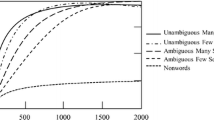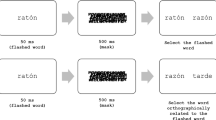Abstract
It is not clear whether multiple unrelated meanings inhibit or facilitate word recognition. Some studies have found a disadvantage for words having multiple meanings with respect to unambiguous words in lexical decision tasks (LDT), whereas several others have shown a facilitation for such words. In the present study, we argue that these inconsistent findings may be due to the approach employed to select ambiguous words across studies. To address this issue, we conducted three LDT experiments in which we varied the measure used to classify ambiguous and unambiguous words. The results suggest that multiple unrelated meanings facilitate word recognition. In addition, we observed that the approach employed to select ambiguous words may affect the pattern of experimental results. This evidence has relevant implications for theoretical accounts of ambiguous words processing and representation.
Similar content being viewed by others
Notes
We thank an anonymous reviewer for this suggestion.
References
Armstrong, B. C., & Plaut, D. C. (2008). Settling dynamics in distributed networks explain task differences in semantic ambiguity effects: Computational and behavioral evidence. In Proceedings of the 30th annual conference of the cognitive science society (pp. 273–278).
Armstrong, B. C., & Plaut, D. C. (2011). Inducing homonymy effects via stimulus quality and (not) nonword difficulty: Implications for models of semantic ambiguity and word recognition. In Proceedings of the 33rd annual conference of the cognitive science society (pp. 2223–2228).
Azuma, T., & Van Orden, G. C. (1997). Why SAFE is better than FAST: The relatedness of a word’s meanings affects lexical decision times. Journal of Memory and Language, 36(4), 484–504.
Baayen, R. H. (2008). Analyzing linguistic data: A practical introduction to statistics using R. Cambridge: Cambridge University Press.
Baayen, R. H., Davidson, D. J., & Bates, D. M. (2008). Mixed-effects modeling with crossed random effects for subjects and items. Journal of Memory and Language, 59, 390–412.
Balota, D. A., Ferraro, F. R., & Connor, L. T. (1991). On the early influence of meaning in word recognition: A review of the literature. In P. J. Schwanenflugel (Ed.), The psychology of word meanings (pp. 187–222). Hillsdale, NJ: Erlbaum.
Balota, D. A., Yap, M. J., Hutchison, K. A., Cortese, M. J., Kessler, B., Loftis, B., et al. (2007). The English Lexicon Project. Behavior Research Methods, 39(3), 445–459. https://doi.org/10.3758/bf03193014.
Bates D., Maechler M., Bolker B., & Walker S. (2014). lme4: Linear mixed-effects models using Eigen and S4. R package version 1, 1–10. http://CRAN.R-project.org/package=lme4.
Beretta, A., Fiorentino, R., & Poeppel, D. (2005). The effects of homonymy and polysemy on lexical access: An MEG study. Cognitive Brain Research, 24(1), 57–65.
Besner, D., & Joordens, S. (1995). Wrestling with ambiguity—further reflections: Reply to Masson and Borowsky (1995) and Rueckl (1995). Journal of Experimental Psychology: Learning, Memory, and Cognition, 21, 515–519.
Borowsky, R., & Masson, M. E. (1996). Semantic ambiguity effects in word identification. Journal of Experimental Psychology: Learning, Memory, and Cognition, 22(1), 63–85.
Duchon, A., Perea, M., Sebastián-Gallés, N., Martí, A., & Carreiras, M. (2013). EsPal: One-stop shopping for Spanish word properties. Behavior research methods, 45(4), 1246–1258.
Duffy, S. A., Morris, R. K., & Rayner, K. (1988). Lexical ambiguity and fixation times in reading. Journal of memory and language, 27(4), 429–446.
Eddington, C. M., & Tokowicz, N. (2015). How meaning similarity influences ambiguous word processing: The current state of the literature. Psychonomic Bulletin & Review, 22(1), 13–37.
Ferraro, F. R., & Kellas, G. (1990). Normative data for number of word meanings. Behavior Research Methods, Instruments, & Computers, 22(6), 491–498. https://doi.org/10.3758/bf03204432.
Forster, K. I., & Bednall, E. S. (1976). Terminating and exhaustive search in lexical access. Memory & Cognition, 4(1), 53–61.
Forster, K. I., & Forster, J. C. (2003). DMDX: A Windows display program with millisecond accuracy. Behavior Research Methods, Instruments, & Computers, 35(1), 116–124.
Fraga, I., Padrón, I., Perea, M., & Comesaña, M. (2017). I saw this somewhere else: The Spanish Ambiguous Words (SAW) database. Lingua, 185, 1–10.
Gernsbacher, M. A. (1984). Resolving 20 years of inconsistent interactions between lexical familiarity and orthography, concreteness, and polysemy. Journal of Experimental Psychology: General, 113(2), 256–281.
González-Nosti, M., Barbón, A., Rodríguez-Ferreiro, J., & Cuetos, F. (2014). Effects of the psycholinguistic variables on the lexical decision task in Spanish: A study with 2,765 words. Behavior Research Methods, 46(2), 517–525.
Hargreaves, I. S., & Pexman, P. M. (2012). Does richness lose its luster? Effects of extensive practice on semantic richness in visual word recognition. Frontiers in Human Neuroscience, 6(234), 1–11.
Haro, J., Demestre, J., Boada, R., & Ferré, P. (2017). ERP and behavioral effects of semantic ambiguity in a lexical decision task. Journal of Neurolinguistics, 44, 190–202.
Haro, J., Ferré, P., Boada, R., & Demestre, J. (2017). Semantic ambiguity norms for 530 Spanish words. Applied Psycholinguistics, 38(2), 457–475.
Hino, Y., Kusunose, Y., & Lupker, S. J. (2010). The relatedness-of-meaning effect for ambiguous words in lexical-decision tasks: When does relatedness matter? Canadian Journal of Experimental Psychology, 64(3), 180–196.
Hino, Y., & Lupker, S. J. (1996). Effects of polysemy in lexical decision and naming: An alternative to lexical access accounts. Journal of Experimental Psychology: Human Perception and Performance, 22(6), 1331.
Hino, Y., Lupker, S. J., & Pexman, P. M. (2002). Ambiguity and synonymy effects in lexical decision, naming, and semantic categorization tasks: Interactions between orthography, phonology, and semantics. Journal of Experimental Psychology: Learning, Memory, and Cognition, 28(4), 686–713.
Hino, Y., Pexman, P. M., & Lupker, S. J. (2006). Ambiguity and relatedness effects in semantic tasks: Are they due to semantic coding? Journal of Memory and Language, 55(2), 247–273.
Jager, B., & Cleland, A. A. (2016). Polysemy advantage with abstract but not concrete words. Journal of psycholinguistic research, 45, 143–156.
Jastrzembski, J. E. (1981). Multiple meanings, number of related meanings, frequency of occurrence, and the lexicon. Cognitive Psychology, 13(2), 278–305.
Jastrzembski, J. E., & Stanners, R. F. (1975). Multiple word meanings and lexical search speed. Journal of Verbal Learning and Verbal Behavior, 14(5), 534–537.
Joordens, S., & Besner, D. (1994). When banking on meaning is not (yet) money in the bank: Explorations in connectionist modeling. Journal of Experimental Psychology: Learning, Memory, and Cognition, 20(5), 1051–1062.
Kellas, G., Ferraro, F. R., & Simpson, G. B. (1988). Lexical ambiguity and the timecourse of attentional allocation in word recognition. Journal of Experimental Psychology: Human Perception and Performance, 14(4), 601–609.
Klepousniotou, E., & Baum, S. R. (2007). Disambiguating the ambiguity advantage effect in word recognition: An advantage for polysemous but not homonymous words. Journal of Neurolinguistics, 20(1), 1–24.
Kuznetsova, A., Brockhoff, P. B., & Christensen, R. H. B. (2014). lmerTest: Tests for random and fixed effects for linear mixed effect models: R package version 2.0-6. http://CRAN.R-project.org/package=lmerTest.
Lin, C.-J. C., & Ahrens, K. (2005). How many meanings does a word have? Meaning estimation in Chinese and English. In J. W. Minett & W. S.-Y. Wang (Eds.), Language acquisition, change and emergence: Essays in evolutionary linguistics (pp. 437–464). Hong Kong: City University of Hong Kong Press.
Lin, C.-J. C., & Ahrens, K. (2010). Ambiguity advantage revisited: Two meanings are better than one when accessing Chinese nouns. Journal of Psycholinguistic Research, 39(1), 1–19.
Masson, M. E., & Borowsky, R. (1995). Unsettling questions about semantic ambiguity in connectionist models: Comment on Joordens and Besner (1994). Journal of Experimental Psychology: Learning, Memory, and Cognition, 21, 509–514.
Masson, M. E. (1991). A distributed memory model of context effects in word identification. In D. Besner & G. W. Humphreys (Eds.), Basic processes in reading: Visual word recognition (pp. 233–263). Hillsdale, NJ: Erlbaum.
Millis, M. L., & Button, S. B. (1989). The effect of polysemy on lexical decision time: Now you see it, now you don’t. Memory & Cognition, 17(2), 141–147.
Parks, R., Ray, J., & Bland, S (1998). Wordsmyth English dictionary—Thesaurus. http://www.wordsmyth.net/ [2016, May].
Pexman, P. M., Hino, Y., & Lupker, S. J. (2004). Semantic ambiguity and the process of generating meaning from print. Journal of Experimental Psychology: Learning, Memory, and Cognition, 30(6), 1252–1270.
Pexman, P. M., Siakaluk, P. D., & Yap, M. J. (2013). Introduction to the research topic meaning in mind: Semantic richness effects in language processing. Frontiers in Human Neuroscience, 7, 1–3.
Real Academia Española. (2014). Diccionario de la lengua española (23rd ed.). Madrid, Spain.
Rodd, J. M., Gaskell, M. G., & Marslen-Wilson, W. D. (2002). Making sense of semantic ambiguity: Semantic competition in lexical access. Journal of Memory and Language, 46(2), 245–266.
Rodd, J. M., Gaskell, M. G., & Marslen-Wilson, W. D. (2004). Modelling the effects of semantic ambiguity in word recognition. Cognitive Science, 28(1), 89–104.
Rueckl, J. G. (1995). Ambiguity and connectionist networks: Still settling into a solution: Comment on Joordens and Besner (1994). Journal of Experimental Psychology: Learning, Memory, and Cognition, 21, 501–508.
Rubenstein, H., Garfield, L., & Millikan, J. A. (1970). Homographic entries in the internal lexicon. Journal of Verbal Learning and Verbal Behavior, 9(5), 487–494.
Simpson, G. B. (1984). Lexical ambiguity and its role in models of word recognition. Psychological Bulletin, 96(2), 316–340.
Tamminen, J., Cleland, A. A., Quinlan, P. T., & Gaskell, M. G. (2006). Processing semantic ambiguity: Different loci for meanings and senses. In Proceedings of the twenty-eighth annual conference of the cognitive science society (pp. 2222–2227).
Yap, M. J., Pexman, P. M., Wellsby, M., Hargreaves, I. S., & Huff, M. J. (2012). An abundance of riches: Cross-task comparisons of semantic richness effects in visual word recognition. Frontiers in Human Neuroscience, 6(72), 1–10.
Funding
Funding was provided by Spanish Ministry of Economy and Competitiveness (Grant No. PSI2015-63525-P), Research Promotion Program of the Universitat Rovira i Virgili (Grant No. 2014PFR-URV-B2-37), and Universitat Rovira i Virgili (Grant No. 2015PMF-PIPF-16).
Author information
Authors and Affiliations
Corresponding author
Rights and permissions
About this article
Cite this article
Haro, J., Ferré, P. Semantic Ambiguity: Do Multiple Meanings Inhibit or Facilitate Word Recognition?. J Psycholinguist Res 47, 679–698 (2018). https://doi.org/10.1007/s10936-017-9554-3
Published:
Issue Date:
DOI: https://doi.org/10.1007/s10936-017-9554-3




